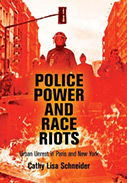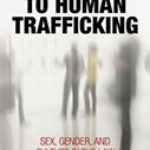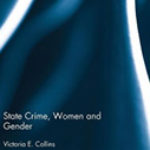Police Power and Race Riots: Urban Unrest in Paris and New York

Author: Cathy Lisa Schneider
Publisher: Philadelphia, PA: University of Pennsylvania Press, 2014. 312p.
Reviewer: P.A.J. Waddington | July 2015
Introduction
This is a book that promises much, but delivers little. The promise is on the front cover, where it purports to be a study of ‘Police Power and Race Riots,’ based upon a comparison of ‘urban unrest in Paris and New York.’ The existing scholarly literature on policing in all its guises contains too little comparative research, perhaps because policing procedures and the criminal law varies so much between jurisdictions. A riot, however, is pretty much the same wherever it occurs: missiles are thrown and premises torched by rioters; people are injured and occasionally killed; and the police equipment and tactics used are very similar across the globe. So, systematically comparing an Anglo–Saxon common law jurisdiction with that in a European Continental Roman law context, should be revealing.
The book is generally very well written. It opens with a brief sketch of two events: the first in 1964, when on the day that President Johnson signed into law the Civil Rights Act, a New York cop shot and killed a fifteen year old African American high school student and sparked a six–day riot. The second was in 2005, in a suburb of Paris, when three non–white youths sought sanctuary from pursuing police officers in an electrical distribution centre and were electrocuted. In this latter case, we read of how one of two boys who were holding hands touched a live piece of equipment killing him and his companion instantly. The remaining boy, though severely burnt escaped and ‘ran, crying hysterically, into the arms of [the brother one of the dead boys] who was on his way to buy food to end the family’s Ramadan fast’ (p2). Such a horror, so graphically told, is guaranteed to grab readers’ attention and compassion, compelling them to turn the pages. Whilst it is certainly a ‘good read’, the academic sceptic might ask if it is good scholarship?
As one such, I fear that the cost of this authorial skill is paid in a crude, simplistic explanatory framework that rests on shallow evidential foundations. The theory, such as it is, invoked to explain urban riots is that brutal cops, enforcing and abusing repressive laws, supported by hard–line politicians, prey upon ethnic minorities who are blamed for all our social ills. When such abuse becomes too unbearable, minority youth rebels explosively. That is, except when they do not, which is explained by social movement organisations opening alternative channels through which anger can be expressed and penalties imposed on erring police officers and financial compensation obtained for victims. This is a neat example of how dissident excluded sections of the population become incorporated into institutionalised channels of expressing dissent.
The evidence for this argument is assembled from an impressive collection of sources: theories of social movements and riots; reports of trials, the publications of non–governmental organisations; news media output; and conversations held with individuals and groups at the forefront of the action — rioters, campaigners and cops. The author’s literary skills do not desert her when citing evidence, for she disarmingly avoids the pretentions of social scientists by telling the reader that she has ‘talked to’ various people and they have ‘told her’ what she then relates. Charming as the author’s style is, it is deceptive — for when she cites an academic source, or the claims of campaigners, or what people have told her, which support her argument, she treats this not as data to be thrown into the analytical mix, but as facts demanding respect. When equivalent sources report, claim or say what is contrary to her view, they are undermined, criticised or just glossed over. More often, they are simply ignored entirely.
Cops cause race riots by brutality
Let us consider the central plank of the author’s argument: that police brutality is the main, if not the only, cause that fuels race riots. The evidence that is adduced for this is a superficial partisan analysis of how local and national politicians can ‘activate racial boundaries’. With the passion of a political campaigner, the author deplores, in turn, Mayor Giuliani and Nicolas Sarkozy. Of Giuliani she writes:
Rudolph Giuliani opened his 1993 mayoral campaign … by addressing a mob of some ten thousand “raucous beer–drinking, overwhelmingly white police officers who had just finished a march on City Hall to protest a Dinkins–backed proposal for civilian oversight over police–misconduct complaints.” Many officers spewed racial epithets and carried signs condemning Dinkins in grossly racial terms, including one that read, “Dump the washroom attendant” (p 135, italics added).
This kind of hyperbole is fine journalism, but vitiates any aspiration to academic rigour and disinterested scholarship. It is far from being a solitary example.
Schneider deplores policies like ‘zero tolerance’ or the creation of special police units that focus their attention on the banlieues (vast public housing projects deposited on the outskirts of many French cities). Apart from their brutality, these policies and special units do not, she insists, ‘work’. Let us pause a moment on this notion of whether a policy ‘works’ or not. She correctly rejects political claims, that such policies have achieved a reduction in crime rates: crime has declined in too many different contexts for it to be explained by any one of them. Does this mean, however, that such policies do not ‘work’? The first imperative of politics is to retain power, and Sarkozy and Giuliani found that ‘get tough’ rhetoric does work in promoting their election and re-election. As she admits, politicians on the ‘left’ implicitly agree, because they too strive to avoid the accusation that they are ‘soft on crime’. The public appetite for tough law and order politics may be irrational, but being rational is not a prerequisite for citizenship, and if the electorate demand ‘kick ass’ polemics, any politician would be crazy not to provide them.
Moving on, the author rests much of her argument on accounts of the violent (often fatal) incidents that spark at least some riots, such as the 1964 New York riot or the 2005 disorders that followed the deaths of the three boys near Paris. There are two reasons for believing that these various accounts do not bear the weight of explanation that the author heaps upon them. The literature on police use of force is not extensive, but it does range across ethnographic studies, clinical assessments, and includes laboratory experiments, all of which lead to the conclusion that such incidents are clouded by uncertainty. Ethnographic studies (Klinger 2004) indicate that police officers find shootings to be so traumatic that they exhibit severe perceptual distortions, such as ‘tunnel vision,’ loss of hearing, scenes drained of colour and time appearing to slow down. Clinicians have strenuously resisted attempts by policy–makers to require officers involved in such encounters to provide immediate statements of what occurred because of their unreliability (Manolias and Hyatt-Williams 1988). Professor Bill Lewinski (a retired cop and now an experimental psychologist) has conducted numerous experiments replicating elements of lethal shootings and found that events occur far too quickly for officers to absorb them all, especially when distractions abound (Lewinski 2002; Lewinski and Grossi 1999; 2003a; Lewinski and Hudson 2003b; 2008). All this clouds the events themselves in ambiguity, uncertainty and confusion, but the author presents a series of descriptive accounts that allow little, if any, scope for ambiguity. The uncertainty, confusion and ambiguity that attend such incidents allow ample scope for accounts to be ‘framed’ by campaigners and journalists (sources on which the author is particularly reliant). ‘Framing’ involves selecting and presenting potentially relevant information so as to advantage movement goals (see, for example: Gamson and Meyer 1996; Johnston and Noakes 2005; Snow and Benford 1992). Given the author’s familiarity with social movements theory, it is surprising that she neither acknowledges the ‘framing’ process, nor reflects it in the manner in which events are described. Invariably, these accounts blame the police for what happened.
Let us consider an example. Despite British police officers not routinely carrying firearms, it does not escape the author’s attention that in 2011 Mark Duggan was shot and killed when the car in which he was a passenger was forcibly stopped by specialist armed officers who claimed that as he alighted from the vehicle Duggan aimed a handgun, concealed in a sock, in their direction. The gun, still inside a sock, was eventually found in undergrowth twenty or so feet from Duggan’s body. The Duggan family maintain that he was unarmed and simply executed, and that the gun was conveniently planted where it could be found later. This was hotly contested at the inquest, held after another man, Kevin Hutchinson–Foster, had been found guilty of supplying Mr Duggan with the weapon found in the undergrowth. The inquest jury returned a verdict of ‘lawful killing’. The shooting itself sparked rioting lasting three days, thus appearing to support the author’s argument. However, Duggan was not alone in being shot by armed police in even more controversial circumstances. In 1999, an entirely innocent man, Harry Stanley, was shot and killed by armed officers when they mistook a table leg he was carrying in a bag for a shotgun. More infamously, Jean Charles de Menezes, a wholly innocent man, was shot dead in July 2005 when mistaken for one of the jihadist gang whose attempt to explode bombs on the London transport system had failed the previous day. Neither Stanley’s nor de Menezes’s deaths provoked any disorder. Why not? What made Duggan’s death so special? Presumably, the answer lies in Duggan’s mixed race, but how does that ‘activate racial boundaries’? Politicians did not glory in his death, indeed from the outset it was treated as problematic, because the gun was not found for many hours and there were those who claimed from the outset that he had been ‘executed’. An official investigation was immediately commenced, as mandated by law, by the Independent Police Complaints Commission (IPCC). The police did mishandle a protest march to the local police station, by providing no senior officer to discuss the case with the family, apparently because it was unclear which agency — police or IPCC — had jurisdiction in the matter. This confusion seems to have sparked the initial confrontation, but the disorder that followed elsewhere had no distinct racial element, as shops were looted for desirable commodities in scenes reminiscent of the Vancouver riots earlier that year, which were apparently sparked by defeat of the local ice hockey team in the Stanley Cup. Schneider takes these complex and inherently confused circumstances and forces them into a simplistic racial frame.
Racial and ethnic conflict is a source of turbulence in many, if not most, modern states. However, it is not the sole cause of tumult. Throughout North America and Europe the devastation caused by the financial crisis has led to rioting, in many cases far more destructive than the ‘race riots’ that are the focus of this book. Are these riots subject to the same social processes as their racial counterparts, or are ‘race riots’ distinctive and, if so, how? Schneider does not answer this query directly, but an answer is implied by her discussion of routine police practices, most notably the use of ‘stop and frisk/search’ laws against ethnic and racial minorities. This deserves more attention than it receives. Schneider is content to leave the issue as one of obvious racial or ethnic discrimination. This leaves the extensive literature on stop and search very largely ignored. My colleagues and I found that in two urban areas of southern England where ‘disproportionality’ seemed high, the ethnic profile of those stopped and searched reflected the ethnic profile of those present in public at times when stop and search tended to occur. We also found that the group who suffered greatest disproportionality was young men, irrespective of their ethnicity (Waddington, Stenson and Don, 2004). As Fitzgerald has remarked, research on the disproportionality of young ethnic minority men in criminal statistics:
… lent no support to the idea that these figures are perennially manufactured by a police service which is so irredeemably racist that it keeps fitting people up for crimes they didn’t commit rather than pursue the real perpetrators (Fitzgerald, 2004, p. 23).
Why does the racial frame become so dominant? Why not ‘youth’ or ‘men’? The answer is not nearly as simple and straightforward as Schneider would have us believe.
References
FitzGerald, M. 2004. "Understanding Ethnic Differences in Crime Statistics." Criminal Justice Matters (55):22-23.
Gamson, William A., and David S. Meyer. 1996. "Framing political opportunity." Pp. 275-90 in Comparative Perspectives on Social Movements, edited by Doug McAdam, John D. McCarthy, and Mayer N. Zald. Cambridge: Cambridge University Press.
Johnston, Hank, and John A. Noakes. 2005. Frames of protest : social movements and the framing perspective. Lanham ; Oxford: Rowman & Littlefield Publishers, Inc.
Klinger, David. 2004. Into the Kill Zone: A Cop’s Eye View of Deadly Force. San Francisco, CA: Jossey–Bass.
Lewinski, Bill. 2002. "Stress reactions related to lethal force encounters." Pp. 23–28 in The Police Marksman.
Lewinski, Bill, and D. Grossi. 1999. "The suspect shot in the back __ Is your shooting clean? Understanding the limits of survival psychology." The Police Marksman XXIV(5):23–25.
Lewinski, Bill, and Bill Hudson. 2003a. "The impact of visual complexity, decision making and anticipation. The Tempe Study, experiments 3 & 5." Pp. 24–27 in The Police Marksman.
—. 2003b. "Time to START shooting? Time to STOP shooting? The Tempe Study." Pp. 26–29 in The Police Marksman.
Lewinski, William. 2008. "The attention study: a study on the presence of selective attention in Firearms Officers." Law Enforcement Executive Forum 8(6):107–39.
Manolias, M., and A. Hyatt-Williams. 1988. "Post-shooting Experiences in Firearms Officers." London: Joint Working Party on Organisational Health and Welfare.
Snow, David A., and Robert D. Benford. 1992. "Master frames and cycles of protest." Pp. 133–55 in Frontiers in Social Movement Theory, edited by Aldon D. Morris and Carol McClurg Mueller. New Haven, Conn.: Yale University Press.
Waddington, P. A. J., Kevin Stenson, and David Don. 2004. "In proportion: race, and police stop and search." British Journal of Criminology 44(6):889-914.
P.A.J. Waddington is Professor of Social Policy at the University of Wolverhampton


